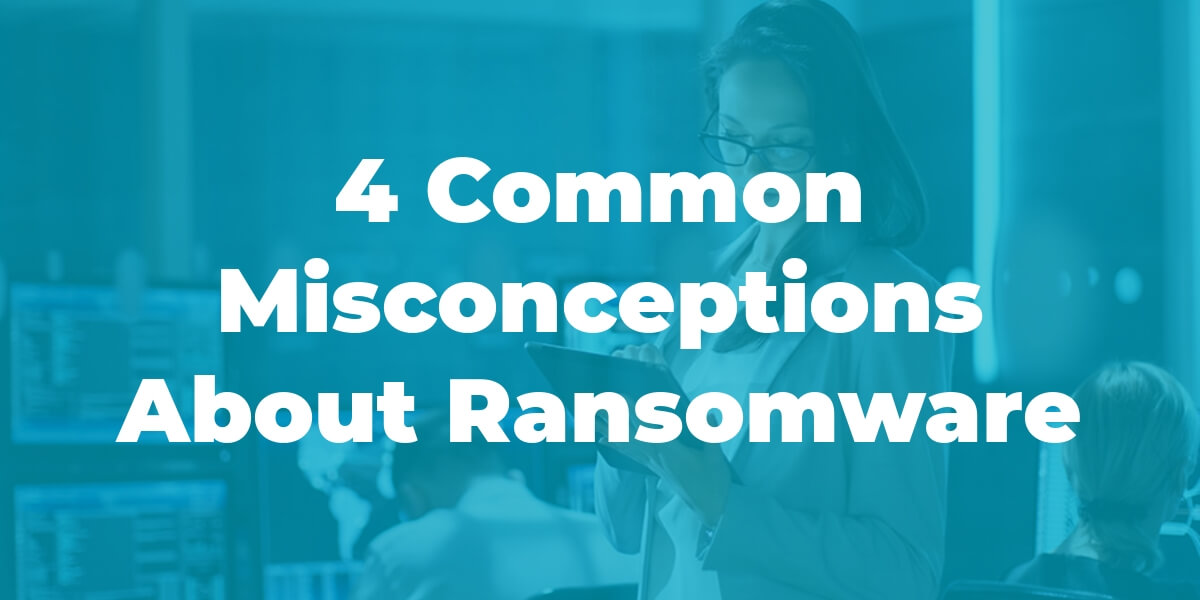In our increasingly digital world, ransomware attacks have become more common, sophisticated, and expensive. Cybercriminals are continuously refining their tactics and targeting businesses of all sizes, making it crucial for organizations to protect their data and systems proactively. Regrettably, many companies fall for widespread ransomware misconceptions, leaving them susceptible to attacks and ill-equipped to respond efficiently if an incident occurs.
This article will expose four of the most persistent ransomware misconceptions and provide the accurate information needed to defend your business. By grasping the true nature of ransomware and implementing proactive measures against it, you can reduce risk and be ready to combat cybercriminals.
Debunking Common Misconceptions
Let's waste no time in addressing the ransomware misconceptions that should be discarded immediately:
Misconception #1: If my business is affected by ransomware, I can pay the ransom and resume operations.
Many businesses assume that paying a ransom is the fastest and simplest method to regain access to encrypted data. This, however, is a dangerous assumption. Paying a ransom does not guarantee the attackers will honor their promise and supply the decryption key. Furthermore, paying ransoms only encourages cybercriminals to conduct additional attacks in the future.
Implementing a robust backup strategy and comprehensive security plan is the most effective way to safeguard your business.
Misconception #2: My backups will enable me to recover if I'm hit with ransomware.
Backups are vital for ransomware prevention, but believing that backups will always save the day is incorrect. Cybercriminals have refined their strategies to include compromising backup files in their attack plans.
The emergence of double extortion attacks has seen cybercriminals not only encrypting data but also stealing it. This means that even with a backup strategy in place, your data may still be at risk if attackers threaten to leak sensitive information unless a ransom is paid.
Misconception #3: My antivirus software (or any other security solution) offers complete protection against ransomware attacks.
While antivirus software is crucial for comprehensive ransomware defense, more is needed. Relying solely on a single security product to guard against ransomware is unwise. No one-size-fits-all solution exists for ransomware. However, employing a defense-in-depth strategy can aid your business in building the most robust possible defense.
Misconception #4: My business isn't a target for ransomware attacks.
Many businesses assume they're not a target for ransomware attacks because they're too small or lack value. This misconception can leave your business exposed. The reality is that organizations of all sizes and industries possess valuable data that cybercriminals can exploit.
As cybercrime becomes more advanced and efficient, hackers have broadened their target base, making businesses of all sizes potential targets. The best defense is to assume your business is a target and proactively protect your data and systems.
Raising Awareness and Strengthening Your Cybersecurity
Beyond debunking common misconceptions, raising awareness and strengthening your organization's cybersecurity is essential to reduce the risk of ransomware attacks.
Here are some additional tips for fortifying your defenses:
Employee education and training: Employees are often the first line of defense against cyberattacks. Ensure your staff is educated on the risks of ransomware, how to recognize suspicious emails, and the importance of reporting any potential threats.
Regular software updates and patches: Keeping your software and operating systems up-to-date is crucial for security. Regularly update and patch your software to protect against known vulnerabilities that cybercriminals may exploit.
Multi-factor authentication (MFA): Implement MFA for all critical systems and applications. This adds an extra layer of security by requiring users to provide multiple forms of identification before accessing your systems.
Regular security assessments: Conduct regular security assessments to identify vulnerabilities in your systems and networks. Remediate any weaknesses discovered during these assessments to minimize the risk of cyberattacks.
Incident response plan: Develop a well-defined incident response plan that outlines the steps your organization will take if a ransomware attack occurs. Ensure that all employees are familiar with the plan and know their roles and responsibilities.
Cybersecurity insurance: Invest in cybersecurity insurance to provide financial protection in case of a ransomware attack. This can help cover the costs of recovering from an attack, such as data restoration and legal expenses.
By implementing these additional measures and fostering a culture of cybersecurity awareness, your organization can further reduce the risk of ransomware attacks and be better prepared to respond effectively in the event of an incident.
Collaborate for Success
To gain further insights into ransomware criminals and how to defend your business, download our infographic, "The Anatomy of a Ransomware Attack." This valuable resource can help enhance your basic understanding of ransomware, recognize the signs if you've been affected, and prepare you to defend against such attacks.
Although no security measure is entirely foolproof, taking proactive steps to secure your data and systems can significantly lower the risk of falling victim to a ransomware attack. We can assist you in ensuring your organization is well-equipped to battle ransomware and other cyber threats. Please feel free to contact us for a no-obligation consultation.
